Assessment of Spatial and Temporal Variation in Water Quality for the Godavari River
Abstract
1. Introduction
2. Methodology
2.1. Study Area
2.2. Selection of Water Quality Parameters
2.3. Data Collection
2.4. Data Analysis
3. Results
3.1. Line Graph Showing the Variation of Water Quality Parameters
3.2. Correlation among Water Quality Parameters
3.3. Analysis of Temporal Variation in the Godavari River Using One-Way ANOVA
4. Discussion
5. Conclusions
Author Contributions
Funding
Data Availability Statement
Conflicts of Interest
References
- Chaplin, M.F. Water: Its importance to life. Biochem. Mol. Biol. Educ. 2001, 29, 54–59. [Google Scholar] [CrossRef]
- Westall, F. The importance of water for life. Space Sci. Rev. 2018, 214, 50. [Google Scholar] [CrossRef]
- Bhardwaj, V.; Singh, D.S.; Singh, A.K. Water quality of the Chhoti Gandak River using principal component analysis, Ganga Plain, India. J. Earth Syst. Sci. 2010, 119, 117–127. [Google Scholar] [CrossRef]
- Bhat, B.; Parveen, S.; Hassan, T. Seasonal assessment of physicochemical parameters and evaluation of water quality of river Yamuna, India. Adv. Environ. Technol. 2018, 4, 41–49. [Google Scholar] [CrossRef]
- Omer, N.H. Water Quality—Science, Assessments and Policy. 2019. Available online: https://www.intechopen.com/books/7718 (accessed on 1 August 2023).
- Srivastava, P.K.; Mukherjee, S.; Gupta, M.; Singh, S.K. Characterizing Monsoonal Variation on Water Quality Index of River Mahi in India using Geographical Information System. Water Qual. Expo. Health 2011, 2, 193–203. [Google Scholar] [CrossRef]
- Venugopal, T.; Giridharan, L.; Jayaprakash, M.; Velmurugan, P.M. A Comprehensive Geochemical Evaluation of the Water Quality of River Adyar, India. Bull. Environ. Contam. Toxicol. 2009, 82, 211–217. [Google Scholar] [CrossRef]
- Khound, N.J.; Bhattacharyya, K.G. Assessment of water quality in and around Jia-Bharali river basin, North Brahmaputra Plain, India, using multivariate statistical technique. Appl. Water Sci. 2018, 8, 221. [Google Scholar] [CrossRef]
- Kharake, A.C.; Raut, V.S. An assessment of water quality index of Godavari river water in Nashik city, Maharashtra. Appl. Water Sci. 2021, 11, 101. [Google Scholar] [CrossRef]
- Bowes, M.J.; Read, D.S.; Joshi, H.; Sinha, R.; Ansari, A.; Hazra, M.; Simon, M.; Vishwakarma, R.; Armstrong, L.K.; Nicholls, D.J.E.; et al. Nutrient and microbial water quality of the upper Ganga River, India: Identification of pollution sources. Environ. Monit. Assess. 2020, 192, 533. [Google Scholar] [CrossRef]
- Lokhande, S.; Tare, V. Spatio-temporal trends in the flow and water quality: Response of river Yamuna to urbanization. Environ. Monit. Assess. 2021, 193, 117. [Google Scholar] [CrossRef]
- Kazmi, A.A.; Hansen, I.S. Numerical models in water quality management: A case study for the Yamuna river (India). Water Sci. Technol. 1997, 36, 193–200. [Google Scholar] [CrossRef]
- Khan, M.Y.A.; Gani, K.M.; Chakrapani, G.J. Assessment of surface water quality and its spatial variation. A case study of Ramganga River, Ganga Basin, India. Arab. J. Geosci. 2016, 9, 28. [Google Scholar] [CrossRef]
- Sharma, M.; Kansal, A.; Jain, S.; Sharma, P. Application of Multivariate Statistical Techniques in Determining the Spatial Temporal Water Quality Variation of Ganga and Yamuna Rivers Present in Uttarakhand State, India. Water Qual. Expo. Health 2015, 7, 567–581. [Google Scholar] [CrossRef]
- Singh, K.P.; Malik, A.; Mohan, D.; Sinha, S. Multivariate statistical techniques for the evaluation of spatial and temporal variations in water quality of Gomti River (India)—A case study. Water Res. 2004, 38, 3980–3992. [Google Scholar] [CrossRef]
- Solaraj, G.; Dhanakumar, S.; Murthy, K.R.; Mohanraj, R. Water quality in select regions of Cauvery Delta River basin, southern India, with emphasis on monsoonal variation. Environ. Monit. Assess. 2010, 166, 435–444. [Google Scholar] [CrossRef]
- Chavan, A.D.; Sharma, M.P.; Bhargava, R. Water Quality Assessment of the Godavari River. Hydro Nepal: J. Water Energy Environ. 2009, 5, 31–34. [Google Scholar] [CrossRef]
- Akkaraboyina, M.K.; Raju, P.S. A Comparative study of water quality indices of River Godavari. Int. J. Eng. Res. Dev. 2012, 2, 29–34. [Google Scholar]
- Amrith, S. Unruly Waters: How Mountain Rivers and Monsoons Have Shaped South Asia’s History; Penguin: London, UK, 2018. [Google Scholar]
- Biksham, G.; Subramanian, V. Sediment transport of the Godavari River basin and its controlling factors. J. Hydrol. 1988, 101, 275–290. [Google Scholar] [CrossRef]
- Jhajharia, D.; Dinpashoh, Y.; Kahya, E.; Choudhary, R.R.; Singh, V.P. Trends in temperature over Godavari River basin in Southern Peninsular India. Int. J. Clim. 2014, 34, 1369–1384. [Google Scholar] [CrossRef]
- Steffen, W.; Jäger, J.; Carson, D.J.; Bradshaw, C. Challenges of a Changing Earth: Proceedings of the Global Change Open Science Conference, Amsterdam, The Netherlands, 10–13 July 2001; Springer: Berlin/Heidelberg, Germany, 2002. [Google Scholar]
- Noori, R.; Bateni, S.M.; Saari, M.; Almazroui, M.; Haghighi, A.T. Strong Warming Rates in the Surface and Bottom Layers of a Boreal Lake: Results From Approximately Six Decades of Measurements (1964–2020). Earth Space Sci. 2022, 9, e2021EA001973. [Google Scholar] [CrossRef]
- Epa, U. United States environmental protection agency. Qual. Assur. Guid. Doc. -Model Qual. Assur. Proj. Plan PM Ambient Air 2001, 2, 12. [Google Scholar]
- Mandal, P.; Upadhyay, R.; Hasan, A. Seasonal and spatial variation of Yamuna River water quality in Delhi, India. Environ. Monit. Assess. 2010, 170, 661–670. [Google Scholar] [CrossRef] [PubMed]
- Matta, G.; Kumar, A.; Nayak, A.; Kumar, P.; Kumar, A.; Tiwari, A.K. Determination of water quality of Ganga River System in Himalayan region, referencing indexing techniques. Arab. J. Geosci. 2020, 13, 1027. [Google Scholar] [CrossRef]
- Noori, R.; Karbassi, A.; Ashrafi, K.; Ardestani, M.; Mehrdadi, N. Development and application of reduced-order neural network model based on proper orthogonal decomposition for BOD5 monitoring: Active and online prediction. Environ. Prog. Sustain. Energy 2013, 32, 120–127. [Google Scholar] [CrossRef]
- Sharma, P.; Meher, P.K.; Kumar, A.; Gautam, Y.P.; Mishra, K.P. Changes in water quality index of Ganges river at different locations in Allahabad. Sustain. Water Qual. Ecol. 2014, 3, 67–76. [Google Scholar] [CrossRef]
- Dung, D.Q.; Pham, D.A. Influence of water temperature and salinity on pH during dry season in lower Dong Nai River system, Vietnam. GeoScience Eng. 2015, 61, 29. [Google Scholar] [CrossRef][Green Version]
- Li, H.; Liu, L.; Li, M.; Zhang, X. Effects of pH, Temperature, Dissolved Oxygen, and Flow Rate on Phosphorus Release Processes at the Sediment and Water Interface in Storm Sewer. J. Anal. Methods Chem. 2013, 2013, 104316. [Google Scholar] [CrossRef]
- Haritash, A.K.; Gaur, S.; Garg, S. Assessment of water quality and suitability analysis of River Ganga in Rishikesh, India. Appl. Water Sci. 2016, 6, 383–392. [Google Scholar] [CrossRef]
- Pote, S.E.; Singal, S.K.; Srivastava, D.K. Assessment of surface water quality of Godavari River at Aurangabad. Asian J. Water Environ. Pollut. 2012, 9, 117–122. [Google Scholar]
- Seo, M.; Lee, H.; Kim, Y. Relationship between Coliform Bacteria and Water Quality Factors at Weir Stations in the Nakdong River, South Korea. Water 2019, 11, 1171. [Google Scholar] [CrossRef]
- Fan, C.; Wang, W.-S. Influence of Biological Oxygen Demand Degradation Patterns on Water-Quality Modeling for Rivers Running through Urban Areas. Ann. N. Y. Acad. Sci. 2008, 1140, 78–85. [Google Scholar] [CrossRef]
- Patil, S.; Ghorade, I. Assessment of physicochemical characteristics of Godavari river water at Trimbakeshwar and Kopargaon, Maharashtra (India). Environment 2013, 3, 149–152. [Google Scholar] [CrossRef]
- Hussain, J.; Husain, I.; Arif, M.; Gupta, N. Studies on heavy metal contamination in Godavari river basin. Appl. Water Sci. 2017, 7, 4539–4548. [Google Scholar] [CrossRef]
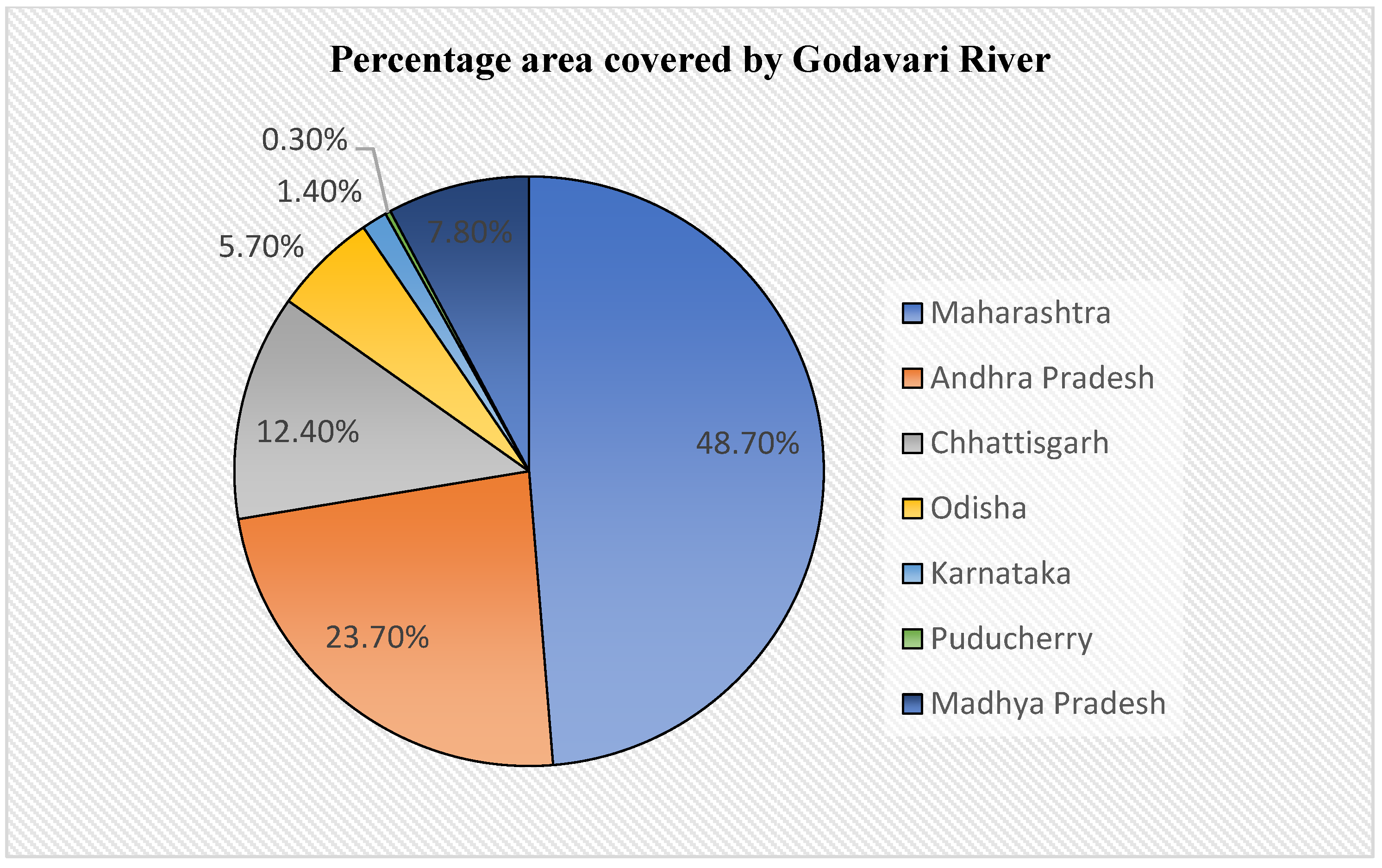

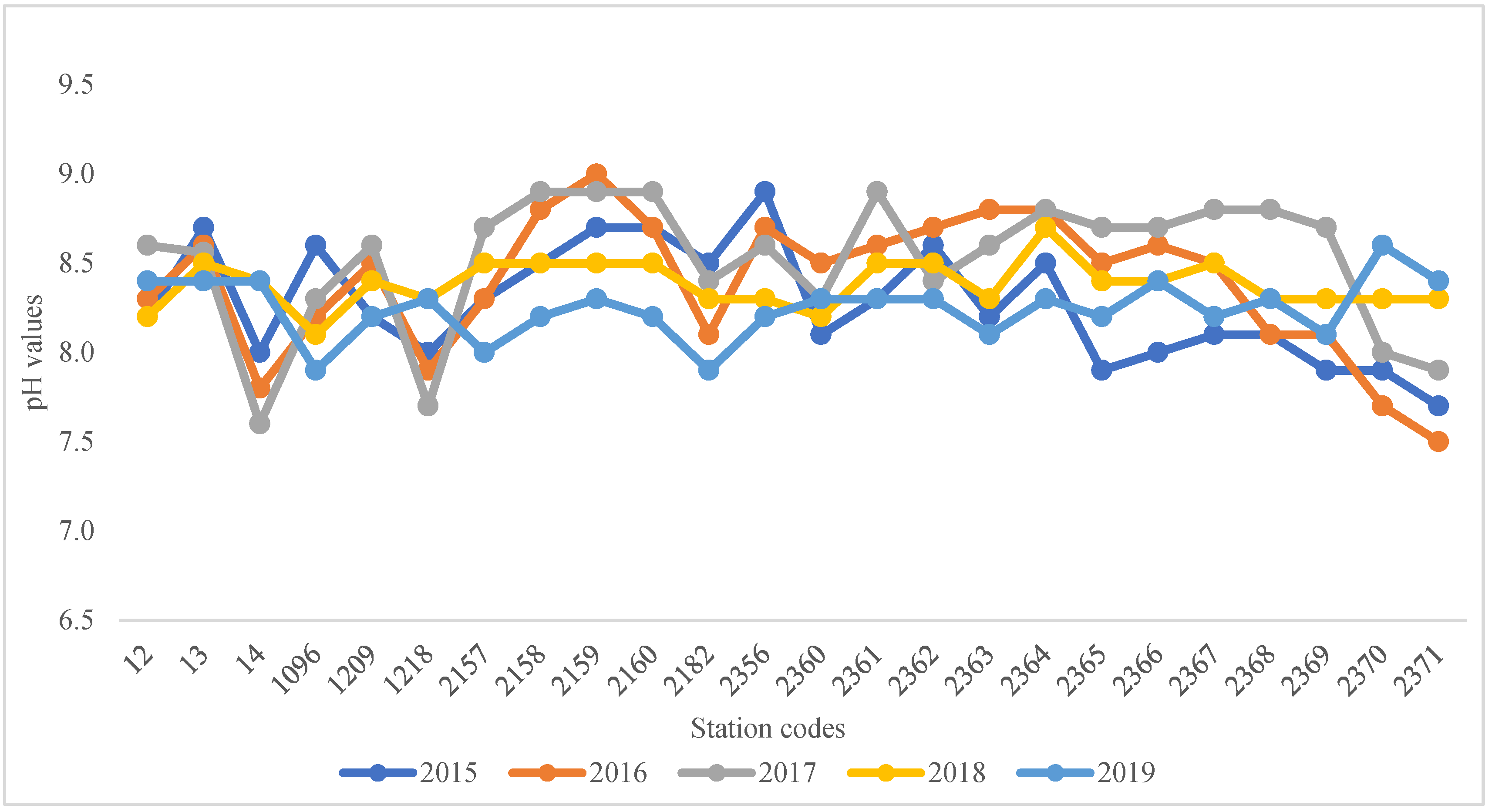
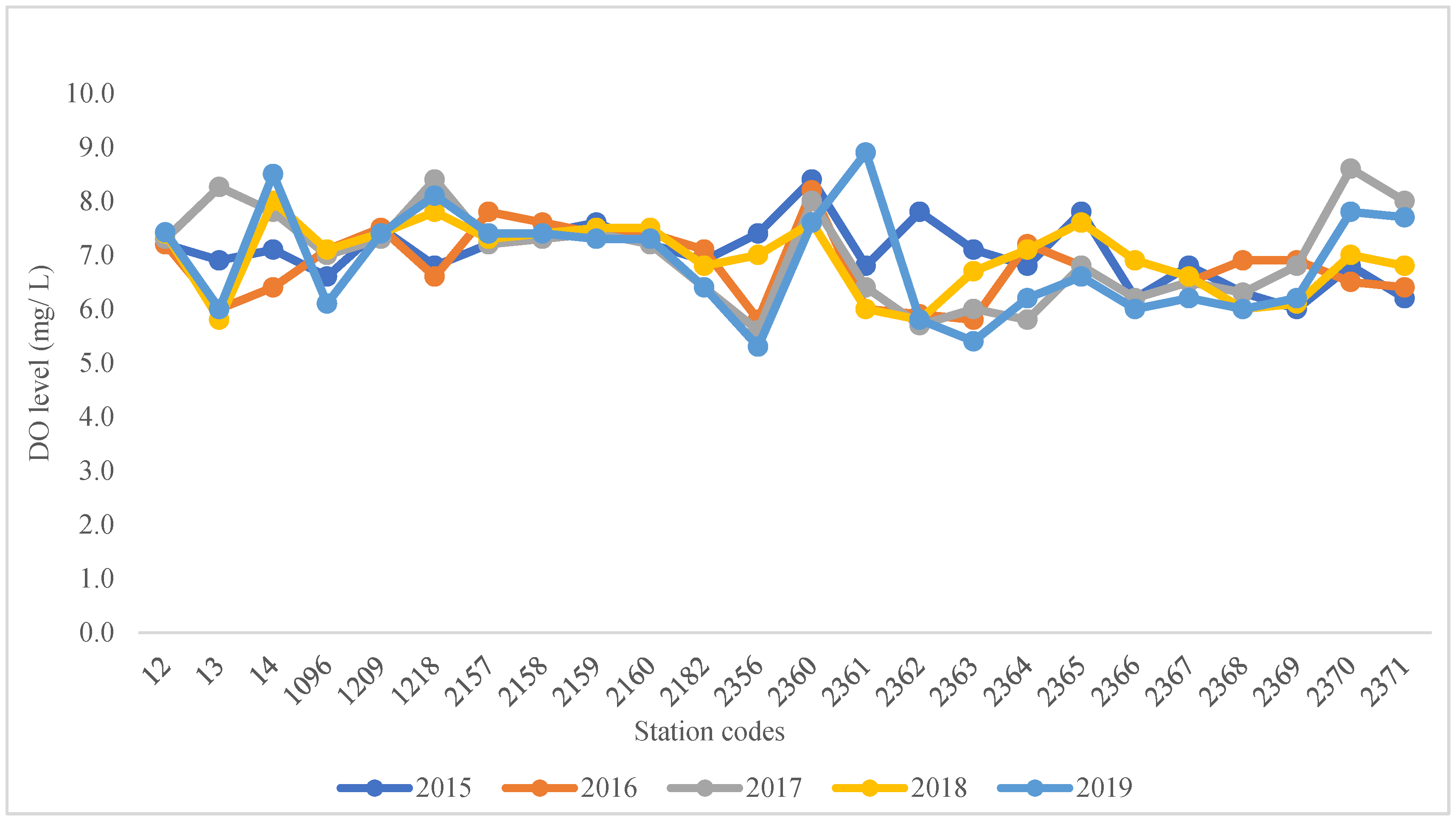
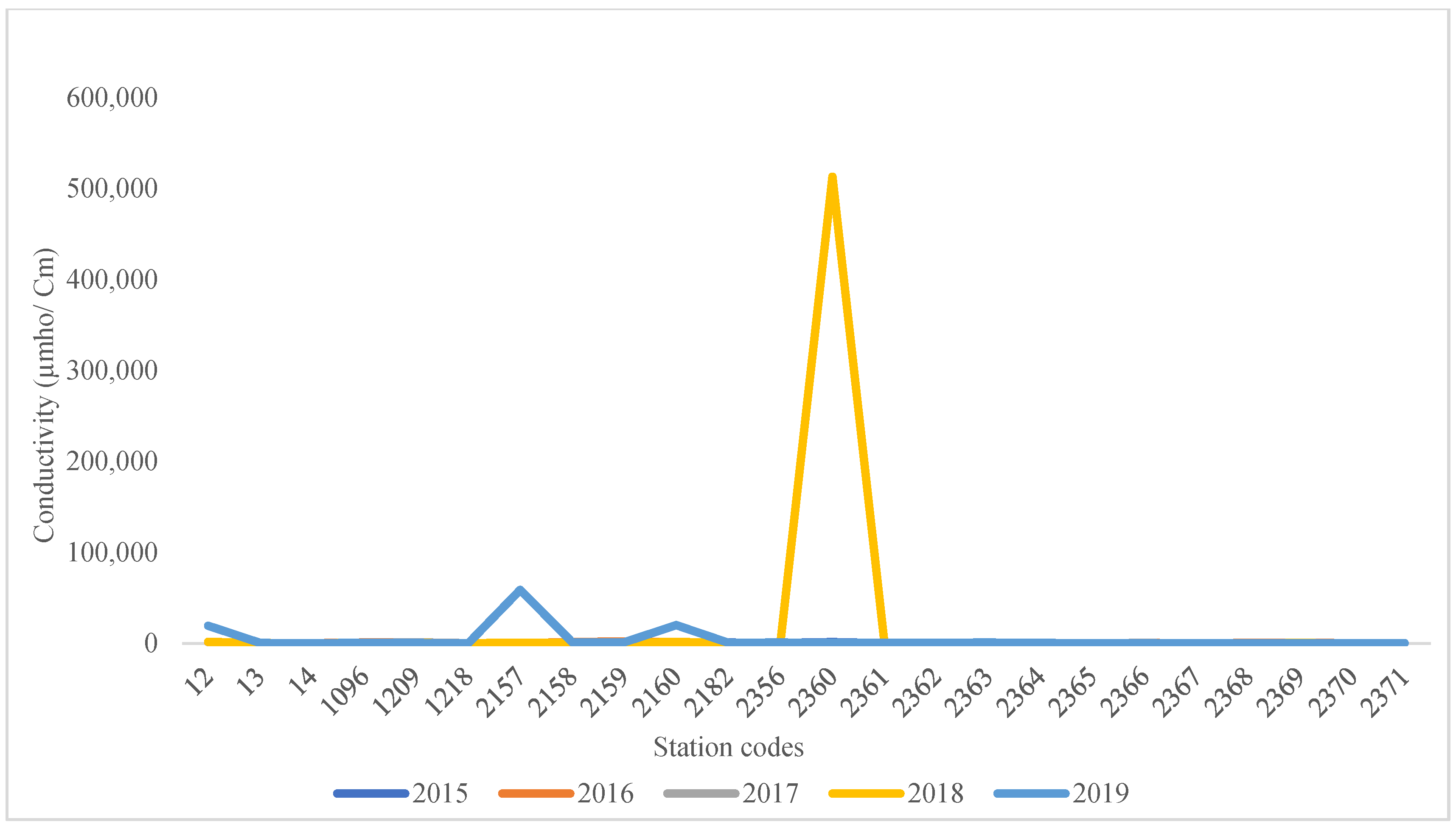
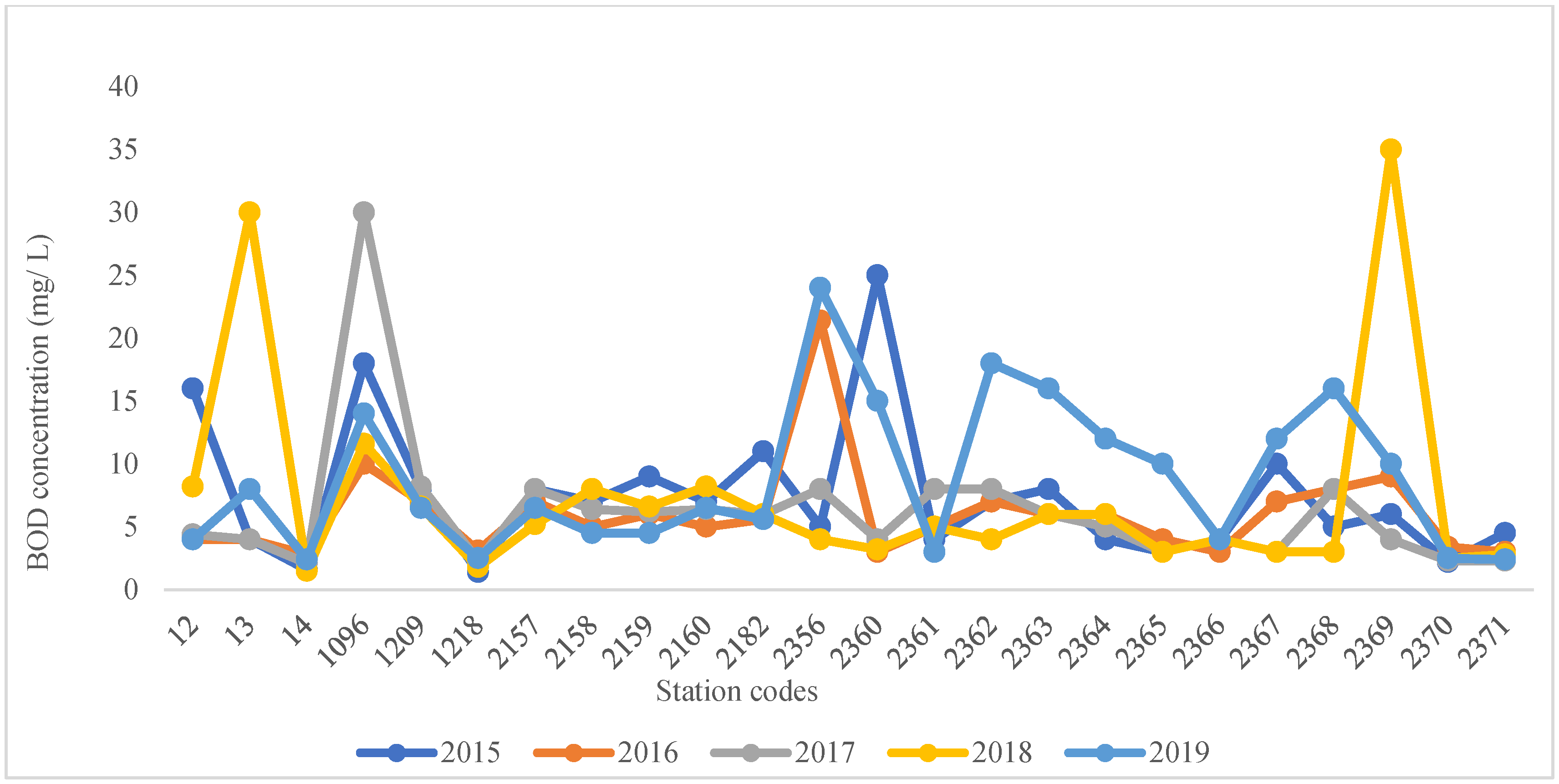

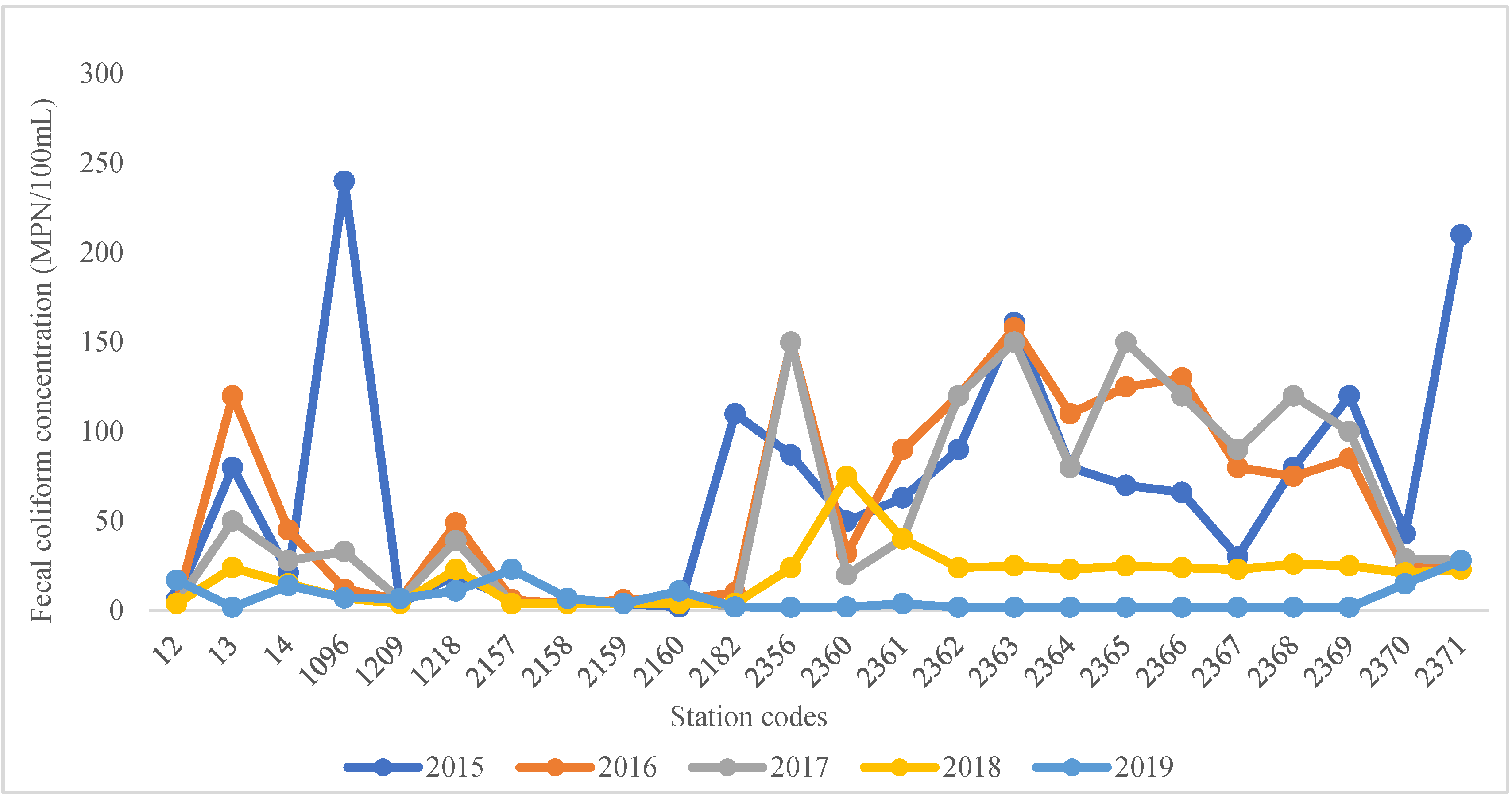
| Year | Parameters | Temperature | DO | pH | Conductivity | BOD | Nitrate | Faecal Coliform |
|---|---|---|---|---|---|---|---|---|
| 2015 | Temperature | 1 | ||||||
| DO | 0.123 | 1 | ||||||
| pH | 0.161 | 0.335 | 1 | |||||
| Conductivity | 0.002 | −0.556 * | 0.273 | 1 | ||||
| BOD | −0.213 | 0.402 | 0.168 | 0.794 * | 1 | |||
| Nitrate | 0.341 | 0.068 | 0.198 | 0.342 | 0.536 * | 1 | ||
| Faecal Coliform | −0.424 | −0.420 | −0.073 | −0.192 | 0.123 | 0.380 | 1 | |
| 2016 | Temperature | 1 | ||||||
| DO | −0.298 | 1 | ||||||
| pH | −0.556 * | 0.058 | 1 | |||||
| Conductivity | −0.465 | 0.416 | 0.473 | 1 | ||||
| BOD | 0.092 | −0.198 | 0.248 | 0.065 | 1 | |||
| Nitrate | 0.082 | −0.201 | −0.032 | −0.266 | 0.191 | 1 | ||
| Faecal Coliform | 0 | −0.731 * | 0.333 | −0.418 | 0.294 | 0.350 | 1 | |
| 2017 | Temperature | 1 | ||||||
| DO | −0.075 | 1 | ||||||
| pH | −0.108 | −0.549 * | 1 | |||||
| Conductivity | 0.173 | −0.170 | 0.114 | 1 | ||||
| BOD | 0.176 | −0.221 | 0.118 | 0.145 | 1 | |||
| Nitrate | −0.106 | −0.380 | 0.082 | −0.046 | −0.163 | 1 | ||
| Faecal Coliform | 0.094 | −0.638 * | 0.186 | −0.117 | −0.073 | 0.664 * | 1 | |
| 2018 | Temperature | 1 | ||||||
| DO | 0.223 | 1 | ||||||
| pH | −0.333 | −0.123 | 1 | |||||
| Conductivity | −0.075 | 0.211 | −0.291 | 1 | ||||
| BOD | 0.130 | −0.442 | −0.006 | −0.107 | 1 | |||
| Nitrate | −0.270 | 0.188 | −0.412 | 0.845 * | −0.208 | 1 | ||
| Faecal Coliform | −0.460 | −0.210 | −0.155 | 0.751 * | −0.060 | 0.713 * | 1 | |
| 2019 | Temperature | 1 | ||||||
| DO | 0.078 | 1 | ||||||
| pH | 0.001 | 0.346 | 1 | |||||
| Conductivity | 0.403 | 0.162 | −0.267 | 1 | ||||
| BOD | −0.170 | −0.748 * | −0.318 | −0.143 | 1 | |||
| Nitrate | 0.110 | −0.112 | −0.226 | −0.011 | 0.437 | 1 | ||
| Faecal Coliform | 0.466 | −0.563 * | 0.203 | 0.536* | 0.540 * | −0.098 | 1 |
| Water Quality Parameter | Source of Variation | SS | df | MS | F |
|---|---|---|---|---|---|
| Temperature (°C) | Between Groups | 263.733 | 4 | 65.93325 | 6.804544 * |
| Within Groups | 1114.303 | 115 | 9.689591 | ||
| Total | 1378.036 | 119 | |||
| pH | Between Groups | 1.09382 | 4 | 0.273455 | 3.08538 * |
| Within Groups | 10.19237 | 115 | 0.088629 | ||
| Total | 11.28619 | 119 | |||
| Dissolved Oxygen (mg/L) | Between Groups | 0.914913 | 4 | 0.228728 | 0.393193 |
| Within Groups | 66.89783 | 115 | 0.58172 | ||
| Total | 67.81275 | 119 | |||
| Conductivity (µmho/Cm) | Between Groups | 8.27 × 1009 | 4 | 2.07 × 109 | 0.931765 |
| Within Groups | 2.55 × 1011 | 115 | 2.22 × 109 | ||
| Total | 2.63 × 1011 | 119 | |||
| BOD (mg/L) | Between Groups | 112.7438 | 4 | 28.18596 | 0.794579 |
| Within Groups | 4079.372 | 115 | 35.4728 | ||
| Total | 4192.116 | 119 | |||
| Nitrate (mg/L) | Between Groups | 88.37806 | 4 | 22.09452 | 2.3165 |
| Within Groups | 1096.857 | 115 | 9.537886 | ||
| Total | 1185.235 | 119 | |||
| Faecal Coliform (MPN/100 mL) | Between Groups | 72,772.34 | 4 | 18193.09 | 8.977362 * |
| Within Groups | 233,053.4 | 115 | 2026.551 | ||
| Total | 305,825.8 | 119 |
Disclaimer/Publisher’s Note: The statements, opinions and data contained in all publications are solely those of the individual author(s) and contributor(s) and not of MDPI and/or the editor(s). MDPI and/or the editor(s) disclaim responsibility for any injury to people or property resulting from any ideas, methods, instructions or products referred to in the content. |
© 2023 by the authors. Licensee MDPI, Basel, Switzerland. This article is an open access article distributed under the terms and conditions of the Creative Commons Attribution (CC BY) license (https://creativecommons.org/licenses/by/4.0/).
Share and Cite
Navasakthi, S.; Pandey, A.; Dandautiya, R.; Hasan, M.; Khan, M.A.; Perveen, K.; Alam, S.; Garg, R.; Qamar, O. Assessment of Spatial and Temporal Variation in Water Quality for the Godavari River. Water 2023, 15, 3076. https://doi.org/10.3390/w15173076
Navasakthi S, Pandey A, Dandautiya R, Hasan M, Khan MA, Perveen K, Alam S, Garg R, Qamar O. Assessment of Spatial and Temporal Variation in Water Quality for the Godavari River. Water. 2023; 15(17):3076. https://doi.org/10.3390/w15173076
Chicago/Turabian StyleNavasakthi, Shibani, Anuvesh Pandey, Rahul Dandautiya, Murtaza Hasan, Mohammad Amir Khan, Kahkashan Perveen, Shamshad Alam, Rajni Garg, and Obaid Qamar. 2023. "Assessment of Spatial and Temporal Variation in Water Quality for the Godavari River" Water 15, no. 17: 3076. https://doi.org/10.3390/w15173076
APA StyleNavasakthi, S., Pandey, A., Dandautiya, R., Hasan, M., Khan, M. A., Perveen, K., Alam, S., Garg, R., & Qamar, O. (2023). Assessment of Spatial and Temporal Variation in Water Quality for the Godavari River. Water, 15(17), 3076. https://doi.org/10.3390/w15173076






